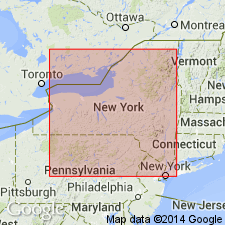
- Usage in publication:
-
- Bald Eagle conglomerate
- Modifications:
-
- Original reference
- Dominant lithology:
-
- Sandstone
- Conglomerate
- AAPG geologic province:
-
- Appalachian basin
Summary:
Pg. 235. Bald Eagle conglomerate. Gray to white, rarely red, conglomerate and quartz sandstone, 550 to 1,319 feet thick. Characterized by extensive cross bedding. Generally called Oneida by Pennsylvania geologists. Is of Lorraine age. Underlies Juniata formation and overlies Eden sandstone. Was originally named "Tyrone," but that name is preoccupied. [Age is Late Ordovician.]
Named from Bald Eagle Mountain at Tyrone, Blair Co., central PA.
Source: US geologic names lexicon (USGS Bull. 896, p. 103-104); supplemental information from GNU records (USGS DDS-6; Reston GNULEX).
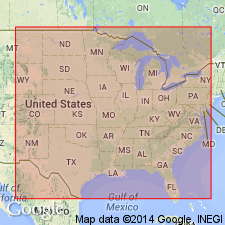
- Usage in publication:
-
- Oswego (Bald Eagle)
- Modifications:
-
- Age modified
- AAPG geologic province:
-
- Appalachian basin
Summary:
Pl. 27. Oswego (Bald Eagle) underlies Juniata sandstone in central Pennsylvania and rests on Reedsville shale, the upper part of which is of Eden age.
Source: US geologic names lexicon (USGS Bull. 896, p. 103-104).

- Usage in publication:
-
- Bald Eagle conglomerate
- Modifications:
-
- Age modified
- AAPG geologic province:
-
- Appalachian basin
Summary:
Pg. 408-410. Bald Eagle conglomerate. The Oswego sandstone must represent upper part of the Bald Eagle. Ulrich makes Bald Eagle exact equivalent of Oswego sandstone without giving reasons for this correlation. To east the sandstone begins earlier and rests on lower beds than to northwest. In Bald Eagle Mountain it rests on lowest Pulaski if not Frankfort; in Buffalo and Pulaski region it is post-Lorraine.
Source: US geologic names lexicon (USGS Bull. 896, p. 103-104).
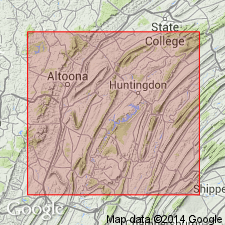
- Usage in publication:
-
- Bald Eagle sandstone†
- Modifications:
-
- Abandoned
- AAPG geologic province:
-
- Appalachian basin
Summary:
Pg. 533, 536. †Bald Eagle sandstone and †Oneida conglomerate of 2nd Pennsylvania Geol. Survey replaced with Oswego sandstone.
Source: US geologic names lexicon (USGS Bull. 896, p. 103-104).
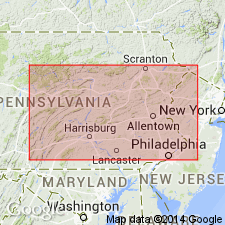
- Usage in publication:
-
- Bald Eagle member
- Modifications:
-
- Revised
- Reinstated
- AAPG geologic province:
-
- Appalachian basin
Summary:
Pg. 1165-1198. Bald Eagle member of Juniata formation. Term Oswego apparently misapplied in Pennsylvania. For beds commonly referred to by that name, term Bald Eagle (Grabau, 1909) is revived and treated as basal member of Juniata. This new applieation of term restricts Martinsburg at top. Consists of massive-bedded, green to gray, coarse sandstone, sometimes speckled with tiny limonitic spots (no conglomerate). The top of the member is transitional with typical red sandstone of Juniata. Where typical red sandstone of Juniata is absent, underlies Tuscarora sandstone; overlies Martinsburg formation, in some areas the Fairview member. Thickness varies from 10 feet to as much as 124 feet. Age is Late Ordovician [Only recorded usage of Bald Eagle at this rank.]
Source: US geologic names lexicon (USGS Bull. 1200, p. 199-200); GNU records (USGS DDS-6; Reston GNULEX).
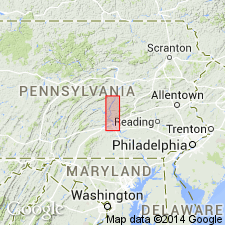
- Usage in publication:
-
- Bald Eagle formation
- Modifications:
-
- Revised
- AAPG geologic province:
-
- Appalachian basin
Summary:
p. 4-5, diagram. At its type section, Bald Eagle formation is about 650 feet thick and consists of poorly winnowed unfossiliferous graywacke-type sandstones, virtually without pebbles except for shale-chips of intraformational type. Formation includes a middle strong ridge-making sandstone member, underlain by weaker shale and sandstone member. Eastward toward Lewistown, ridge-making member of Bald Eagle sandstone becomes conglomeratic, with pebbles of vein quartz, quartz-veined quartzites, cherts and jaspers, and rarely of quartz-veined meta-argillites. This conglomerate is here named Lost Run conglomerate. Overlies Reedsville shale and at eastern limit Martinsburg shale; underlies unnamed sandstone member of Juniata. [Age is Late Ordovician.]
Source: US geologic names lexicon (USGS Bull. 1200, p. 199-200).
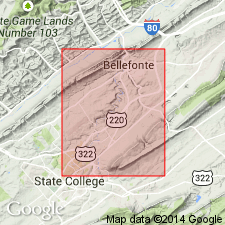
- Usage in publication:
-
- Bald Eagle formation
- Modifications:
-
- Revised
- AAPG geologic province:
-
- Appalachian basin
Summary:
Bald Eagle sandstone, in type area, subdivided into Centennial School sandstone and shale member below and Spring Mount sandstone member (both new). Underlies East Waterford red sandstone member (new) of Juniata; overlies Reedsville shale. [Age is Late Ordovician.]
Source: US geologic names lexicon (USGS Bull. 1200, p. 199-200).
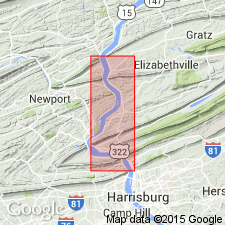
- Usage in publication:
-
- Bald Eagle formation
- Modifications:
-
- Areal extent
- AAPG geologic province:
-
- Appalachian basin
Summary:
Pg. 7, pl. 1. Bald Eagle formation. Comprises typically dark-gray, greenish, well-cemented, poorly sorted graywacke and orthoquartzite. Basal part commonly conglomeratic. Thickness 30 feet at Susquehanna Gap; nearly 1,000 feet in central Pennsylvania. Underlies Juniata formation. Contact with underlying Reedsville transitional; contact arbitrarily placed at youngest occurrence of ORTHORHYNCHULA. [Age is Late Ordovician.]
Source: US geologic names lexicon (USGS Bull. 1200, p. 199-200).
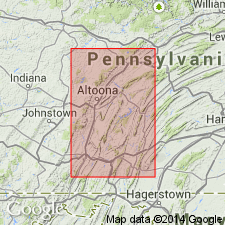
- Usage in publication:
-
- Bald Eagle Formation
- Modifications:
-
- Areal extent
- AAPG geologic province:
-
- Appalachian basin
Summary:
Geographically extended to MD and WV. Consists of green to gray-green unfossiliferous sandstone, with significant thickness of interbedded shale and siltstone near base. Overlies Martinsburg; underlies Juniata.
Source: GNU records (USGS DDS-6; Reston GNULEX).
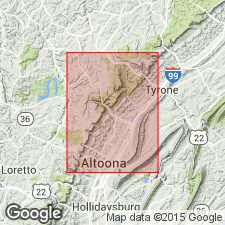
- Usage in publication:
-
- Bald Eagle Formation
- Modifications:
-
- Overview
- AAPG geologic province:
-
- Appalachian basin
Summary:
Unit is recognized throughout the Valley and Ridge province in central PA. Dominant lithology is medium-gray to greenish-gray subgraywacke sandstone. Weathers to olive gray and brownish gray. Some sandstone quartzitic. Generally fine-grained. Planar cross-bedding common; trough cross-bedding in beds of quartzitic sandstone. Secondary lithology is medium gray thin-bedded siltstone. Most siltstone beds occur with shale and mudstone in lower part of unit. Conformably overlies the Reedsville Formation. Gradationally underlies the Juniata Formation and contact is placed at gray to grayish-red color change. Thickness calculated at 275+/-25 m. Age is Late Ordovician.
Source: GNU records (USGS DDS-6; Reston GNULEX).
For more information, please contact Nancy Stamm, Geologic Names Committee Secretary.
Asterisk (*) indicates published by U.S. Geological Survey authors.
"No current usage" (†) implies that a name has been abandoned or has fallen into disuse. Former usage and, if known, replacement name given in parentheses ( ).
Slash (/) indicates name conflicts with nomenclatural guidelines (CSN, 1933; ACSN, 1961, 1970; NACSN, 1983, 2005, 2021). May be explained within brackets ([ ]).

